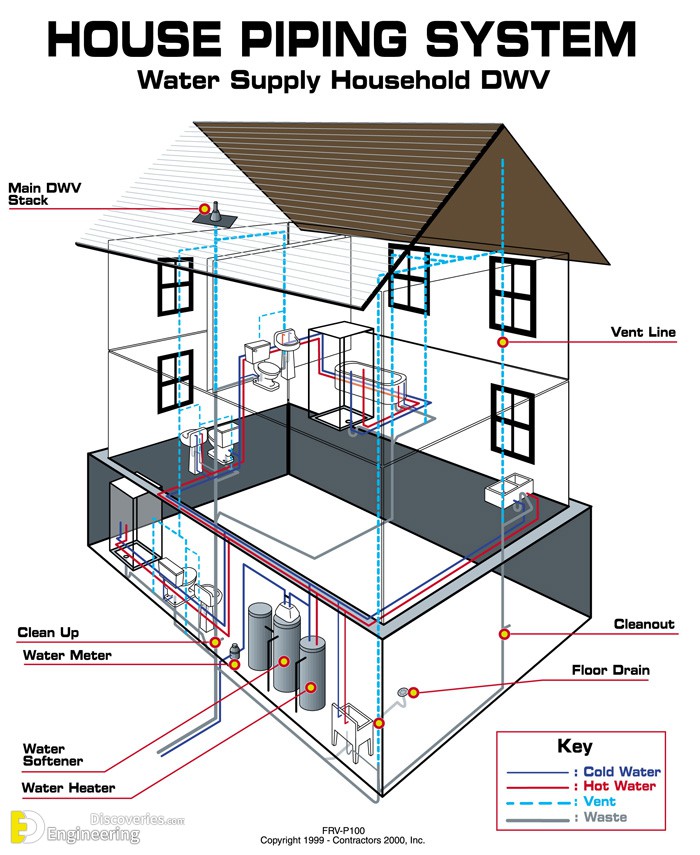The writer is making a few great pointers about Anatomy of a House: Understanding the Components in general in this article just below.

Recognizing just how your home's plumbing system functions is necessary for every single home owner. From providing tidy water for drinking, cooking, and showering to safely eliminating wastewater, a well-maintained plumbing system is critical for your household's health and wellness and convenience. In this detailed overview, we'll discover the elaborate network that makes up your home's pipes and deal tips on upkeep, upgrades, and handling common issues.
Intro
Your home's plumbing system is more than simply a network of pipelines; it's a complicated system that guarantees you have access to clean water and reliable wastewater removal. Understanding its components and exactly how they collaborate can assist you prevent pricey repair work and guarantee every little thing runs smoothly.
Standard Components of a Pipes System
Pipelines and Tubes
At the heart of your pipes system are the pipelines and tubing that lug water throughout your home. These can be made of various materials such as copper, PVC, or PEX, each with its advantages in regards to resilience and cost-effectiveness.
Components: Sinks, Toilets, Showers, and so on.
Components like sinks, commodes, showers, and bath tubs are where water is utilized in your house. Recognizing exactly how these components link to the plumbing system assists in diagnosing issues and intending upgrades.
Valves and Shut-off Factors
Valves control the circulation of water in your pipes system. Shut-off shutoffs are important during emergency situations or when you need to make fixings, enabling you to separate parts of the system without disrupting water flow to the entire residence.
Supply Of Water System
Main Water Line
The major water line attaches your home to the municipal supply of water or an exclusive well. It's where water enters your home and is distributed to numerous components.
Water Meter and Stress Regulator
The water meter procedures your water use, while a pressure regulator ensures that water flows at a safe pressure throughout your home's plumbing system, avoiding damages to pipelines and components.
Cold Water vs. Hot Water Lines
Recognizing the difference in between cold water lines, which provide water directly from the primary, and hot water lines, which lug warmed water from the water heater, aids in fixing and planning for upgrades.
Drain System
Drain Pipes Pipeline and Traps
Drain pipes carry wastewater far from sinks, showers, and bathrooms to the sewage system or sewage-disposal tank. Traps protect against drain gases from entering your home and additionally catch debris that can trigger obstructions.
Air flow Pipelines
Ventilation pipes permit air into the water drainage system, stopping suction that could slow water drainage and trigger catches to vacant. Proper air flow is important for preserving the integrity of your pipes system.
Importance of Correct Drain
Making certain correct drainage avoids backups and water damage. Regularly cleaning drains pipes and maintaining traps can avoid costly repair services and expand the life of your pipes system.
Water Heater
Types of Hot Water Heater
Water heaters can be tankless or typical tank-style. Tankless heating systems warm water on demand, while containers store heated water for immediate usage.
How Water Heaters Attach to the Pipes System
Understanding how hot water heater link to both the cold water supply and warm water distribution lines aids in detecting issues like insufficient warm water or leakages.
Upkeep Tips for Water Heaters
Routinely flushing your water heater to eliminate debris, checking the temperature settings, and evaluating for leakages can expand its life-span and enhance power effectiveness.
Common Plumbing Issues
Leakages and Their Reasons
Leaks can occur due to aging pipes, loosened installations, or high water pressure. Attending to leaks immediately stops water damages and mold development.
Clogs and Blockages
Clogs in drains pipes and commodes are often brought on by flushing non-flushable items or a buildup of grease and hair. Utilizing drainpipe displays and bearing in mind what decreases your drains can stop obstructions.
Indicators of Plumbing Issues to Look For
Low tide pressure, sluggish drains, foul odors, or uncommonly high water costs are indicators of possible pipes troubles that must be resolved promptly.
Plumbing Upkeep Tips
Regular Assessments and Checks
Set up annual pipes examinations to capture problems early. Search for indicators of leaks, corrosion, or mineral build-up in faucets and showerheads.
DIY Maintenance Tasks
Easy tasks like cleaning faucet aerators, checking for toilet leakages using color tablets, or protecting exposed pipes in chilly climates can prevent significant pipes problems.
When to Call an Expert Plumbing Professional
Know when a pipes issue calls for expert competence. Trying complex repair work without proper expertise can result in more damage and greater repair service expenses.
Upgrading Your Plumbing System
Reasons for Upgrading
Upgrading to water-efficient components or changing old pipes can boost water quality, minimize water expenses, and raise the worth of your home.
Modern Pipes Technologies and Their Advantages
Explore modern technologies like smart leakage detectors, water-saving commodes, and energy-efficient water heaters that can save cash and reduce ecological influence.
Expense Factors To Consider and ROI
Calculate the in advance prices versus long-lasting savings when considering pipes upgrades. Lots of upgrades pay for themselves via lowered utility bills and fewer repair work.
Environmental Influence and Preservation
Water-Saving Fixtures and Appliances
Mounting low-flow faucets, showerheads, and bathrooms can dramatically reduce water usage without giving up performance.
Tips for Decreasing Water Usage
Simple habits like taking care of leaks quickly, taking shorter showers, and running full lots of laundry and recipes can conserve water and lower your utility expenses.
Eco-Friendly Pipes Options
Consider lasting pipes products like bamboo for flooring, which is durable and green, or recycled glass for countertops.
Emergency situation Preparedness
Actions to Take Throughout a Plumbing Emergency
Know where your shut-off shutoffs are located and exactly how to switch off the water supply in case of a ruptured pipeline or major leakage.
Relevance of Having Emergency Situation Calls Helpful
Keep call info for neighborhood plumbing professionals or emergency solutions readily available for fast reaction throughout a pipes dilemma.
DIY Emergency Situation Fixes (When Suitable).
Short-lived solutions like utilizing air duct tape to spot a dripping pipeline or positioning a container under a dripping tap can reduce damage until a professional plumber gets here.
Verdict.
Comprehending the anatomy of your home's pipes system encourages you to preserve it effectively, conserving money and time on repairs. By adhering to routine maintenance routines and remaining educated regarding modern pipes innovations, you can ensure your pipes system runs efficiently for years ahead.
Understanding Your Home Plumbing System: A Comprehensive Guide
Plumbing System: The Lifeline of Your Home
At its core, the plumbing system is designed to perform two primary functions: bring fresh water into your home and remove wastewater. The system is a network of pipes, fixtures, and other components that transport water and sewage. Residential plumbing systems include potable water supply lines, drain-waste-vent (DWV) systems, and various plumbing fixtures that make water use in daily tasks possible.
Key Components:
Water Supply: This part of your plumbing system brings municipal water into your home, passing through the main water supply line. It s responsible for supplying all water needs, from drinking to bathing.
Drainage System: It carries waste and water away from your home to the sewer or septic system. This system includes all the piping within your home that leads to external sewage or septic systems.
Vent System: An essential yet often overlooked component, the vent system allows sewer gases to escape and lets air into the drainpipes, ensuring water and waste move correctly through the system.
Fixture: More Than Just Taps and Toilets
Plumbing fixtures are the most interactive parts of the plumbing system, including faucets, showers, toilets, and sinks. Each fixture is connected to the plumbing system and plays a role in either the delivery of freshwater or the disposal of waste and wastewater.
Types of Fixtures:
Faucets and Sinks: Used for washing hands, dishes, and other daily water needs. Toilets: Dispose of human waste through the sewage system. Bathtubs and Showers: Provide bathing facilities, requiring both hot and cold water supply. Water Supply: The Source of Life
The water supply system is a critical component, ensuring that potable water is available throughout your home for various uses, including drinking, cooking, and cleaning. This system consists of pipes that distribute water to different parts of the house, controlled by valves to regulate the water flow.
Types of Plumbing: Materials and Methods
Various types of plumbing systems and materials are used in residential settings, each with its advantages and applications. From copper and PVC pipes for water supply to cast iron and ABS for drainage, the choice of materials can impact the longevity and efficiency of your plumbing system.
https://intownplumbingtx.com/articles/home-plumbing-system-guide/

I'm just very taken with Understanding Your Home's Plumbing Anatomy and I really hope you enjoyed reading my page. Be sure to take the opportunity to distribute this post if you enjoyed reading it. Many thanks for your time. Kindly stop by our site back soon.
Detail
 Mara Wilson Then & Now!
Mara Wilson Then & Now! Hallie Eisenberg Then & Now!
Hallie Eisenberg Then & Now! Michael C. Maronna Then & Now!
Michael C. Maronna Then & Now! Sydney Simpson Then & Now!
Sydney Simpson Then & Now! James Van Der Beek Then & Now!
James Van Der Beek Then & Now!